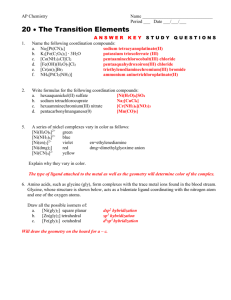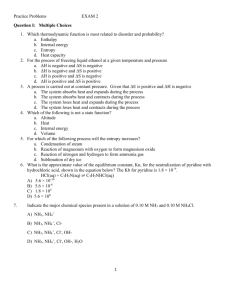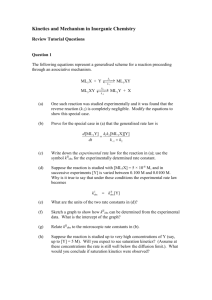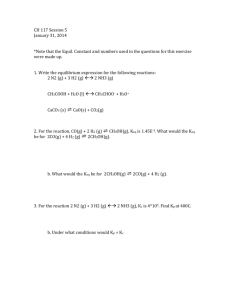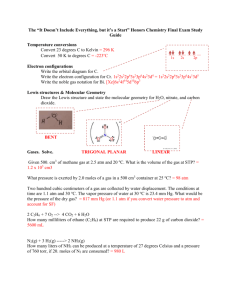Unit 5 Coordination Chemistry Graduate Center Inorganic Chemistry
advertisement
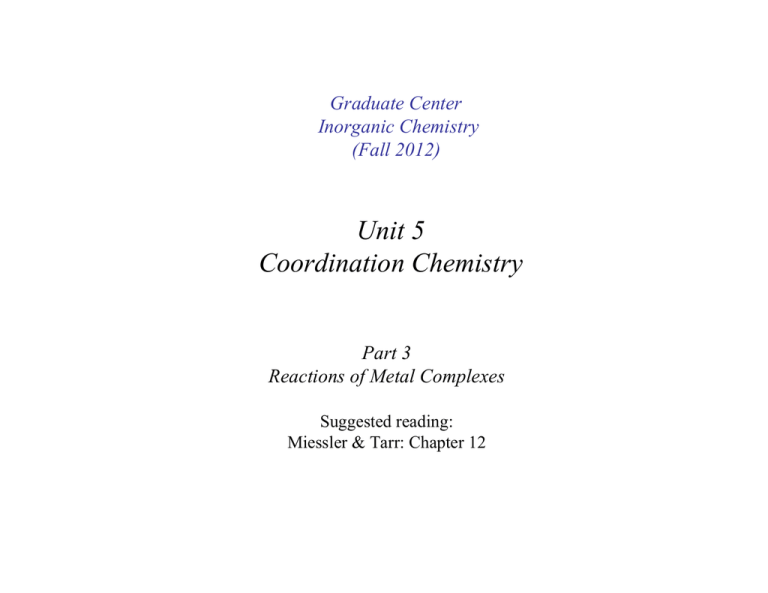
Graduate Center Inorganic Chemistry (Fall 2012) Unit 5 Coordination Chemistry Part 3 Reactions of Metal Complexes Suggested reading: Miessler & Tarr: Chapter 12 Chemical reactions move from one energy minimum (reactants) through a higher energy structure (transition state) to another energy minimum (products) Free Energy Free Energy ΔG# MX + Y MXY ΔG# MX + Y MY + X no intermediate intermediate Extent of the reaction (a) MY + X Extent of the reaction (b) Principle of microscopic reversibility Steady-state approximation Parameters that can be obtained by kinetic experiments • Order of the reaction • Rate constant (speed of the reaction) By studying the reaction at different temperatures: • Free energy of activation • Enthalpy (heat) • Entropy Inclusion of pressure dependence: • Volume of activation (whether the transition state is larger or smaller than the reactants) Main types of reactions - Substitution Reactions - Oxidation-Reduction Reactions - Reactions of the ligands that do not change the attachments to the metal center Substitution reactions MLn + L' MLn-1L' + L Labile complexes <==> Fast substitution reactions (< few min) Inert complexes <==> Slow substitution reactions (>h) a kinetic concept Not to be confused with stable and unstable (a thermodynamic concept ΔGf <0) Inert Intermediate Labile d3, low-spin d4 , d4, d6 strong-field d8 (sq-pl) d8 (weak-field) d1, d2, high-spin d4, d5, d6 & d7, d9 , d10 Mechanisms of ligand exchange reactions in octahedral complexes MLn X + Y MLn Y + X Detection of intermediates not possible Ia if association is more important Id if dissociation is more important No clear-cut evidence to distinguish them Kinetics of dissociative reactions Steady-state approximation Rates of formation and reaction of the intermediate must be equal Detectable Intermediate! Kinetics of interchange reactions Fast equilibrium K1 = k1/k-1 k2 << k-1 For [Y] >> [ML5X] common experimental condition! Dissociative and interchange reactions rate = K[M]0[Y] [X] + K'[Y] Dissociative rate = K[M]0[Y]0 1 + K'[Y]0 Interchange At low conc. of Y both reactions become second order (first order in M and Y) with the rate of the dissociative reaction slowing as more free X is forming At high conc. of Y (more common), second term in denominator larger, reaction first order in complex and zero order in Y Kinetics of associative reactions Rate determining step At any [Y] Change from one rate law to the other depends on the specific values of the rate constants Similarity of the rate laws limits their usefulness in determining the mechanism Mechanisms of ligand exchange reactions in square planar complexes L L K2 = KY X L L M X -X Two-term rate laws rate = K1[ML3X] + K2[ML3X][Y] Y L -d[ML 3X]/dt = (ks + ky [Y]) [ML3X] M X L L L +Y L S +S M L L M S L +Y Y L -X L Rh(I) Ir(I) Ni(II) Pd(II) Pt(II) L Au(III) L L M Y -S L M S K1 = KS Principal mechanisms of ligand exchange in octahedral complexes Dissociative ML5 X k1 slow ML5 + X +Y k2 fast r = k 1 [ML5X] ML5 Y Associative ML5 X + Y k1 slow ML5 XY -X k2 fast r = k 1 [ML5X][Y] ML5 Y Dissociative pathway (5-coordinated intermediate) MOST COMMON Associative pathway (7-coordinated intermediate) Experimental evidence for dissociative mechanisms Rate is independent of the nature of L Experimental evidence for dissociative mechanisms Rate is dependent on the nature of L Inert and labile complexes Some common thermodynamic and kinetic profiles Exothermic (favored, large K) Large Ea, slow reaction Exothermic (favored, large K) Large Ea, slow reaction Stable intermediate Endothermic (disfavored, small K) Small Ea, fast reaction Labile or inert? L L L M L L Ea L L L L M L L M L L L X L X ΔG LFAE = LFSE(sq pyr) - LFSE(oct) Why are some configurations inert and some are labile? Inert ! Substitution reactions in square-planar complexes the trans effect L X M T +X, -Y L L M T (the ability of T to labilize X) Strong Π acceptors followed by strong σ donors Y L Synthetic applications of the trans effect g) h) Greater lability of Cl- Explanations of the trans effect (σ-bonding and Π bonding) Trans effect is dominated by 2 factors: weakening of the Pt-X bond and stabilization of the presumed 5-coordinate transition state σ- bonding effect • Pt-X bond is influenced by the Pt-T bond (both use the Pt px and dx2-y2 orbitals) • If Pt-T σ bond strong, it uses part of the orbitals and leaves less for Pt-X bond. Then Pt-X bond weaker and its ground state (σ-bonding orbital) is higher in E leading to smaller Ea for breaking this bond. This ground state effect is called the trans influence and applies primarily to the leaving group (thermodynamic effect) contributes to the overall kinetic result by changing the reactant ground state. • This part of the explanation predicts the order for the trans effect based on the relative σ-donor properties of ligands H- > PR3 > SCN- > I- similar CH3- sim CO sim CN- > Br- > Cl- > NH3 > OH- Explanations of the trans effect (σ-bonding and Π bonding) Π- bonding effect When the T ligand forms a strong Π-acceptor bond with Pt, charge is removed from Pt and the entrance of another ligand to form a 5-coordinate species more likely. dx2-y2 and dxz and dyz orbitals can contribute to Π-bonding in the trigonal-bipyramidal transition state. Effect on the ground state of the reactant is small, but the energy of the TS is lowered and then reducing Ea Order of Π-acceptor ability of ligands: C2H4 sim CO > CN- > NO2- > SCN- > I- > Br- > Cl- > NH3 > OHCombination of the two effects: Electron transfer (redox) reactions -1e (oxidation) M1(x+)Ln + M2(y+)L’n M1(x +1)+Ln + M2(y-1)+L’n +1e (reduction) Very fast reactions (much faster than ligand exchange) May involve ligand exchange or not Very important in biological processes (metalloenzymes) Outer sphere mechanism [Fe(CN)6]3- + [IrCl6]3- [Fe(CN)6]4- + [IrCl6]2- [Co(NH3)5Cl]+ + [Ru(NH3)6]3+ [Co(NH3)5Cl]2+ + [Ru(NH3)6]2+ Reactions ca. 100 times faster than ligand exchange (coordination spheres remain the same) A B "solvent cage" r = k [A][B] Tunneling mechanism Ea A + Ligands with Π or p e- or orbitals that can be used in bonding good for tunneling NH3 (no low-lying antibonding orbitals) do not B A' ΔG + B' Inner sphere mechanism [Co(NH3)5Cl)]2+ + [Cr(H2O)6]2+ [Co(NH3)5Cl)]2+:::[Cr(H2O)6]2+ Step 1: formation of a bridging ligand [CoIII(NH3)5(μ-Cl)CrII(H2O)6]4+ [Co(NH3)5Cl)]2+:::[Cr(H2O)6]2+ Step 2: transfer of e- (frequently accompanied by transfer of the ligand) [CoII(NH3)5(μ-Cl)CrIII(H2O)6]4+ [CoIII(NH3)5(μ-Cl)CrII(H2O)6]4+ Step 3: separation of products [CoII(NH3)5(μ-Cl)CrIII(H2O)6]4+ [CoII(NH3)5(H2O)]2+ + [CrIII(H2O)5Cl]2+ [CoII(NH3)5(H2O)]2+ Also tunneling mechanism by a single ligand [Co(H2O)6]2+ + 5NH3 Inner sphere mechanism Ox-X + Red k1 Ox-X-Red k2 Reactions much faster than outer sphere electron transfer (bridging ligand often exchanged) k3 k4 Ox(H2O)- + Red-X+ Ox-X-Red Tunneling through bridge mechanism r = k’ [Ox-X][Red] k’ = (k1k3/k2 + k3) Ea Ox-X + Red Ox(H2O)- + Red-X+ ΔG


